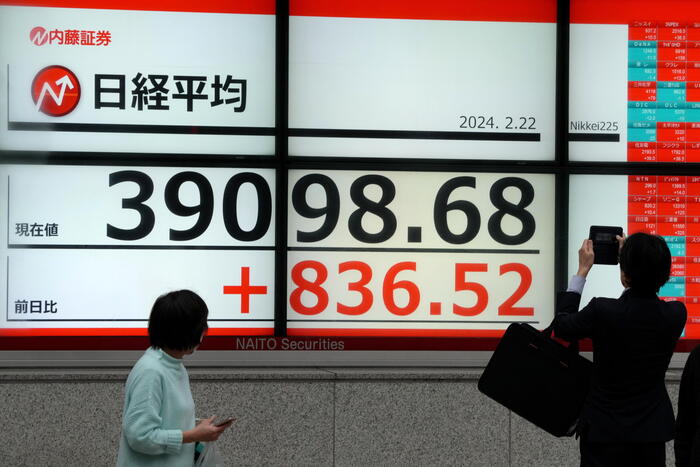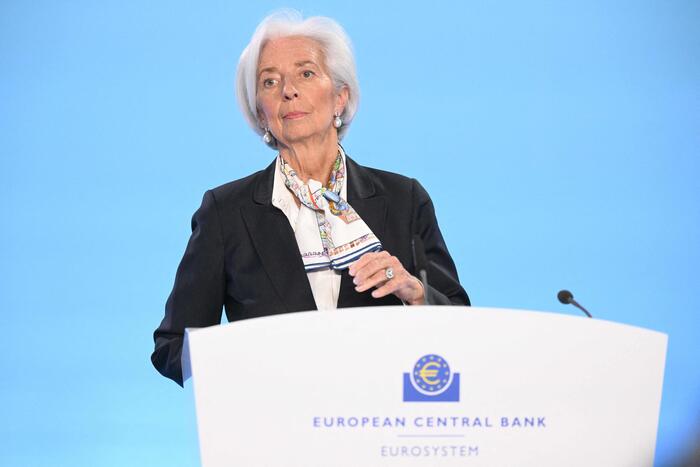A woman walks past a cryptocurrency exchange panel in Seoul on February 17.KIM CHUL-SOO / EFE
Just ten months ago the bomb went off.
The Texas oil price, the benchmark in the United States, was drilling through the ground until it fell into negative territory.
The pandemic stoppage and excess supply caused investors to charge $ 38 to get a barrel of the liquid formerly known as black gold.
The news that shook the markets now seems only a distant memory.
A barrel of
brent
this week touched $ 65, its highest in a year.
And Texas is around 60.
It is not just oil.
Raw materials such as copper are hitting their ceiling in nearly a decade these days, driven by growing demand in China.
The Stock Exchanges of the United States and Asia (not so much the European ones; and even less the Spanish one) swim in abundance.
And bitcoin crushes all its marks one day, only to surpass them again the following week.
Powered by the grace of Tesla founder Elon Musk, the most popular cryptocurrency is already trading for $ 55,000.
Its total capitalization has reached one trillion dollars.
In the third edition of his book
Irrational Exuberance,
published in 2015, the Nobel laureate in economics Robert J. Shiller said that it seemed logical to think that people would have learned the lesson of the last financial blow not to turn to the expanding markets. .
"But the evidence that bubbles exist has been precipitating since the crisis," he added.
Some voices now warn of an excessive heating of the markets.
The question is whether we are only witnessing a rational improvement or the genesis of another bubble in one of the expanding sectors.
The experts consulted lower the alarm tone.
The most widespread idea is that the markets already see the end of the economic crisis caused by the pandemic that, thanks to vaccines, could be overcome during the second half of the year.
There are dangers to financial stability, yes: there is fear both that a new mutation of the coronavirus will destroy everything that has been advanced as well as an excessive heating of the markets that will end up generating high inflation or new bubbles.
But those risks, for now, are low.
The fuel that burns the most wood is clear.
The stimulus packages that the governments of half the world have approved to fight the crisis - lately, the plan of 1.9 trillion dollars (1.6 trillion euros) that in the US is finalizing the Biden Administration -, as well as the The flow of funds injected for a long time by the central banks fills the economy with liquidity.
“It is true that there is an accumulation of stimuli that can be even excessive, but in these moments it is better to err on the side of prudence.
If nothing goes wrong along the way, we will be able to see a way out of the crisis that is somewhat more powerful than we thought recently, ”says José Manuel Amor, Afi's director of Financial Analysis.
"Things are simply returning to their normal course, to a normality of an economy that, at the end of 2019, before the coronavirus earthquake, was slowly slowing down," adds analyst Juan Ignacio Crespo.
A certain normality is, for example, that a barrel of
brent is
trading around 63 dollars.
It is true that the rally in crude is heavily influenced by circumstantial factors such as the historic freeze in Texas or the cut in production in Saudi Arabia, but there is also a bottom stream of improved demand and economic prospects.
The Stock Exchanges also benefit from these better expectations, but here the joy goes through neighborhoods.
While the New York indices of the Dow Jones and S&P have more than recovered their pre-crisis levels - not to mention the technological Nasdaq, which almost double its level of March of last year - Europeans are still far from having gained everything they lost for the coronavirus crisis.
The Spanish Ibex is trading almost 20% below where it was a year ago.
High valuation
At their meeting in January, officials from the US Federal Reserve expressed concern about the high valuation of some assets, according to the minutes published this week.
The European Central Bank also discussed in its last meeting the possibility that the recent increase in profitability in the debt market is anticipating upward pressure on prices.
But the body headed by Christine Lagarde rules out inflationary risks and continues to bet on maintaining its stimuli.
Returning to the title of the Nobel Shiller's book, to what extent do these ups and downs respond to fundamental economic data or are they just another example of markets that are increasingly difficult to understand?
“The bases of this exuberance are the cheap money policies of the central banks.
There is a great deal of irrationality in some movements, especially in cryptocurrencies.
Everything indicates that some segments of the market are falling into excesses, "the president of Renta 4, Juan Carlos Ureta, responded to this newspaper on Thursday at an event organized to discuss the
GameStop case
and the massive entry of retail investors in the Stock Market.
"When volatility in financial markets comes from psychological phenomena, it is not good, because the markets start to look like casinos," added the former president of the CNMV, Manuel Conthe.
Another case of exuberance in the markets, in this case quite irrational.
The fear of inflation returns
Another feature of return to a certain normality is that the yield of the US and German bonds moves away from the low of last year.
But the abrupt change in the sovereign debt of the first power, the most pronounced since 2018, also alerts those who believe that this stimulus festival will end up being paid by the consumer, with higher prices.
The experts consulted ask, however, for caution.
Ramón Forcada, Bankinter's chief economist, admits that there will be higher inflation in the second half of the year, but at totally manageable levels: “It may scare the market a bit, but the inflationary rebound is going to be temporary.
And that is not going to mean a rapid rise in interest rates.
No central banker is going to gamble until the cycle is consolidated. ”José Manuel Amor even dares to set a date for the next rate hikes:“ Nobody expects this to happen until the potential output gap closes and the figures for unemployment.
That will not happen before 2023 or 2024. And that in the US In Europe we are more behind, "concludes the Afi analyst.

/cloudfront-eu-central-1.images.arcpublishing.com/prisa/YLM2KW6SZREO52DGHLPGNHLG5Q.jpg)







